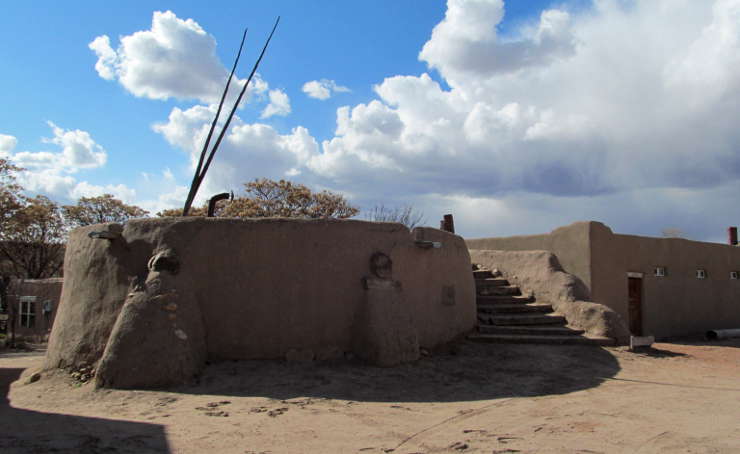Nambe Pueblo
- Nambé: People of the Round Earth
- Language: Tewa
- Size: 19,500 acres
- Population: 1,100
The Pueblo of Nambé is one of six Tewa-speaking pueblos in northern New Mexico. The Tewa migrated from the Four Corners area in the late 1200s, during a time of extended drought. When they reached the northern Rio Grande area now known as "Tewa Basin", they found it populated with indigenous people. It took several generations but eventually the Tewas merged with the indigenous people and their language and better technology took off from there.
On the east side of the Rio Grande and upstream on the Rio Nambé, Nambé has been known historically for its agricultural products and traditional textile and pottery production.
The Pueblo is nestled in the foothills of the Sangre de Cristo Mountains about 20 miles north of Santa Fe, almost completely surrounded by mostly Hispanic non-Indian towns. That has led to significant encroachment on pueblo lands over the years. The pueblo lands consist of juniper, scrub oak and outcroppings of sandstone with towering cottonwoods in the riparian zone along the river. The Rio Nambé begins about 5 miles east of the pueblo boundary, high in the mountains. It flows through the pueblo and eventually feeds into the Rio Grande.
As part of the San Juan Chama project, the Bureau of Reclamation built a dam on the river above Nambé Falls to store irrigation water for the Pojoaque Valley. That gave birth to the Nambé Falls Recreation Area, an area the pueblo opened for public use. In 2011, the Pacheco Fire burned half the watershed that feeds the Rio Nambé. That resulted in a complete kill of the fish in the lake, which resulted in the pueblo closing the area except for day hikers, overnight campers and participants in group events.

The Kiva at Nambé
Pueblo History
Archaeological evidence points to the first Nambé people arriving in the area around 1350 CE from what is now the Bandelier National Monument area. Previous to Bandelier they had been in the Four Corners/Mesa Verde area but a long term drought had forced them to move closer to the steadier water supply near the Rio Grande. Then the Bandelier area got dry, too...
At first, there were several small villages located in defensive positions in the hills east of today's pueblo area and in wetter years, the people came down into today's pueblo area to farm. Between about 1425 and 1550 most of the people left the higher mountains and settled in today's Nambé, building the pueblo we see today. Only one village high in the mountains survived. Between 1550 and 1700 that last village in the mountains was abandoned and the entire people were settled in the pueblo area. When the Spanish came, they liked the look and feel of the area so they settled very close by. That began a process which, over the years, has led to intermarrying and a mixing of blood that has made today's Nambé one of the least "native" of all pueblos.
The first Spanish church was built next to the pueblo center in the early 1600s. At the same time, the Spanish introduced peppers, fruit trees, alfalfa, wheat, grapes, sheep and cattle to the farmers. Like most other pueblos, Nambé was a participant in the Pueblo Revolt of 1680 and like most pueblos, Nambé suffered when the Spanish returned in force in 1692. However, Spanish rule was less harsh after 1692 and with the establishment of a Spanish settlement nearby, the resulting mixing of cultures took more of the harshness away. However, an indirect result of the 1680 Revolt was the acquisition of horses by the Plains tribes and after 1700, raids by the Comanches and Apaches became a serious problem throughout the pueblos.
Spanish Governor Juan Bautista de Anza was successful in essentially taming the Comanches in 1776 but the Apaches were a problem in some areas right up into the 1880s. A nastier problem in the pueblos was smallpox with epidemics passing through and reducing the population regularly. It seems to have been a smallpox epidemic in the late 1820s that virtually ended the making of pottery at Nambé.
Pottery History
The Nambé pottery tradition is similar to that of Picuris and Taos with the use of a micaceous clay slip and with black-on-black and white-on-red designs. Recent Nambé pottery has been principally sgraffito-decorated blackware bowls, plain tan jars and larger micaceous slip jars and bowls.
Archaeologists working over the trash piles of the old pueblo have uncovered potsherds dating back to the 1200s CE. In some piles, remnants of pottery indicate high levels of trade among the various pueblos with Nambé trading some pottery but mostly agricultural products. That trade increased after about 1400 CE as most of the pueblos felt a decreased need for defensive security and their people moved to more open habitations where industry and agriculture could expand. Even today Nambé is known more for agriculture than for pottery.